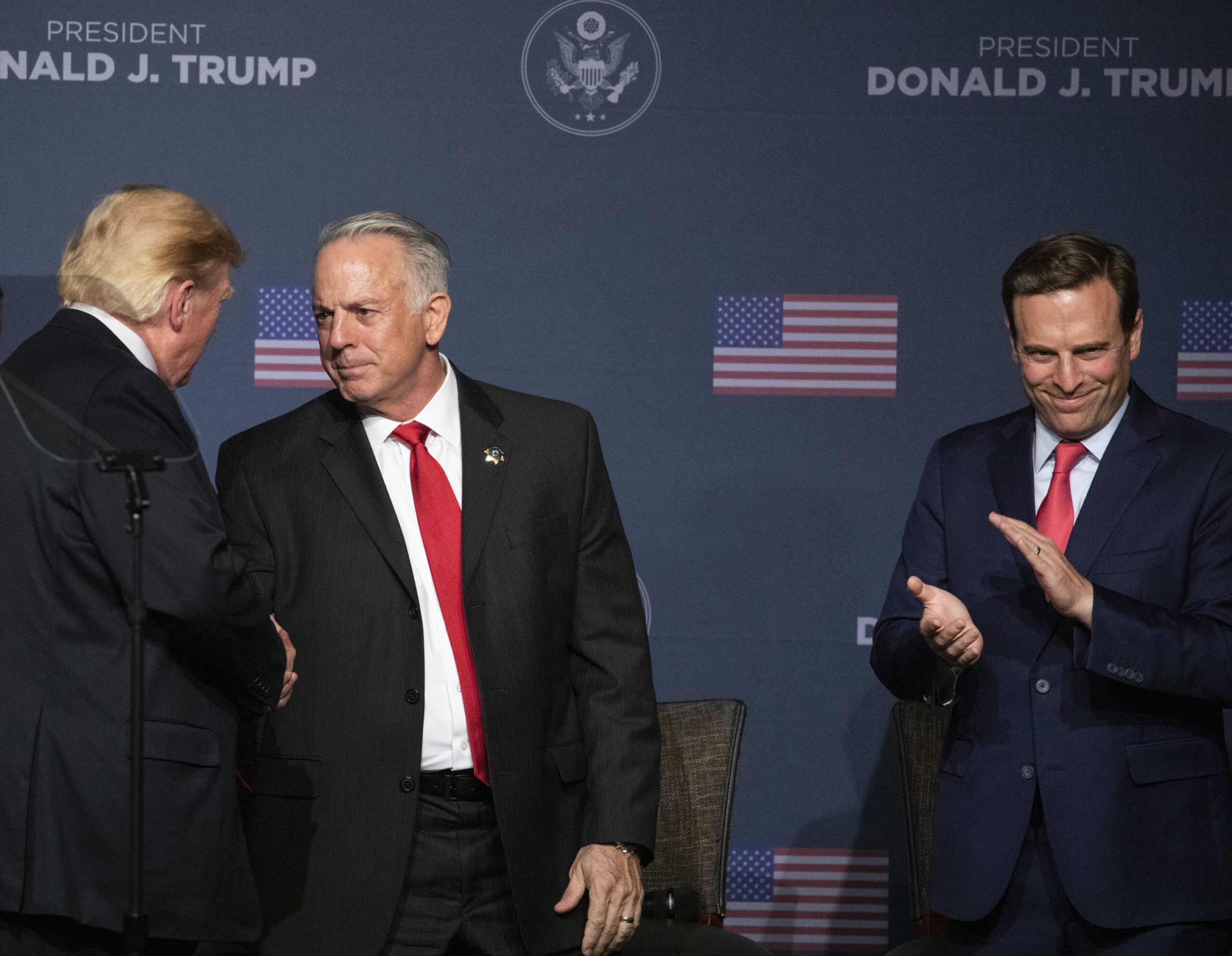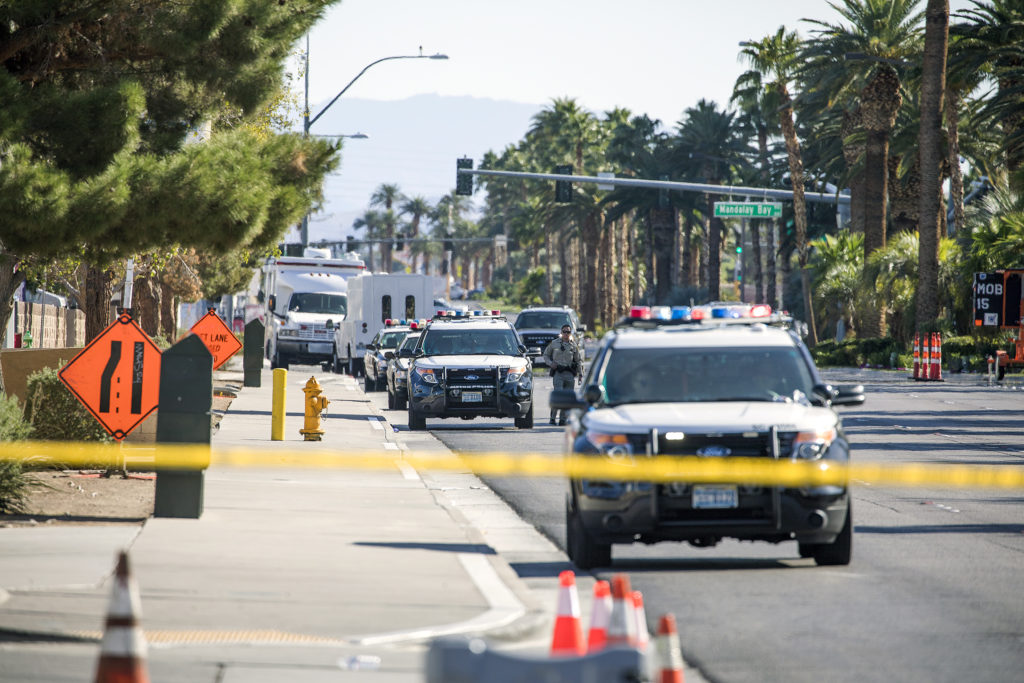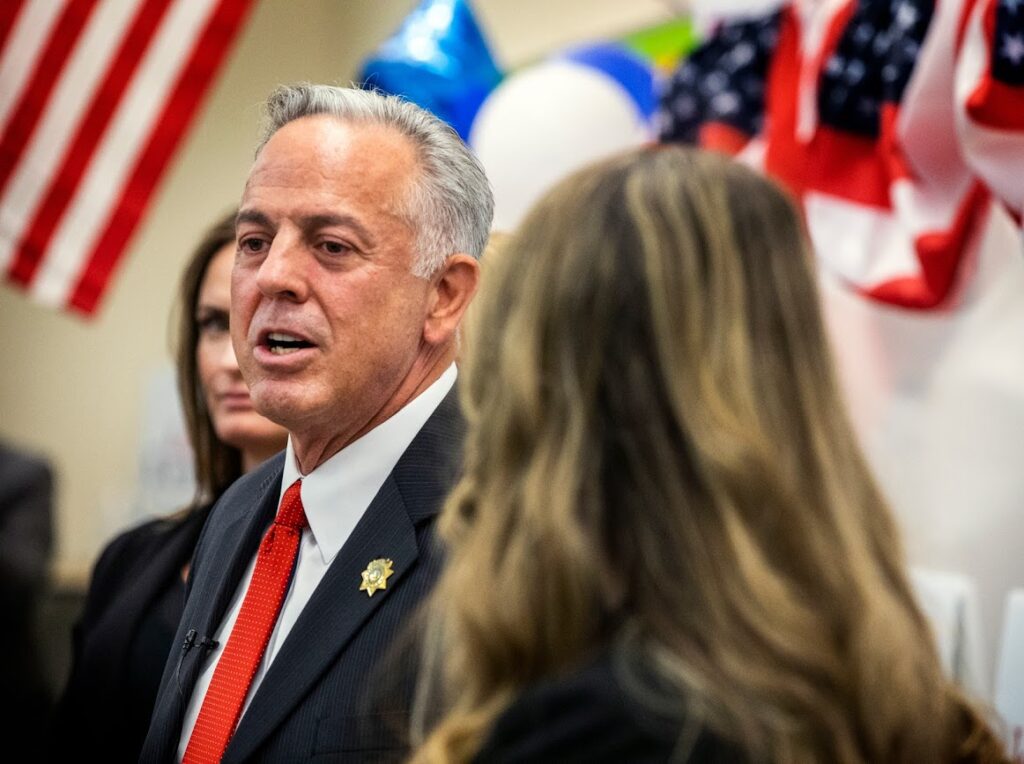Fact check: Has Nevada become a crime ‘cesspool’ on Lombardo’s watch?

Speaking before a boisterous Las Vegas crowd last month, former President Donald Trump delivered a scolding, 45-minute speech blaming Democrats for rising national crime rates while also describing Nevada as a “cesspool of crime.”
That comment provided some awkwardness for the candidates sitting alongside Trump — Clark County Sheriff Joe Lombardo and former Nevada Attorney General Adam Laxalt, the Republican nominees for governor and U.S. Senate, respectively.
And the remark has since provided Gov. Steve Sisolak and other Democrats with fodder to attack Lombardo, the top cop in the state’s most populous county, and flip the script from typically Republican attacks casting Democrats as “soft on crime.”
Last month, Sisolak’s campaign launched a television ad using Trump’s comment to attack Lombardo as a “failed sheriff,” while Democratic groups have also hosted events and run ads blaming Lombardo for rising homicides and below-average staffing levels at the Las Vegas Metropolitan Police Department (Metro), which Lombardo has headed since 2015.
But which statements about Lombardo are accurate, and which claims stretch the truth?
Below, The Nevada Independent fact-checked several of the most common attacks on Lombardo and some notable remarks made about crime in Nevada. Click on one of the following links to jump to a specific claim:
- Is Nevada a ‘cesspool’ of crime?
- Have homicides in Clark County increased under Lombardo?
- Did changes to Metro’s anti-gang unit under Lombardo drive an increase in crime?
- Are police officer-to-citizen ratios below average at Metro?
- Does Lombardo support defunding the police?
- Have property crimes risen during Lombardo’s tenure as sheriff?
- Have police response times slowed under Lombardo?
Is Nevada a ‘cesspool’ of crime?
“Nevada is a cesspool of crime.”
— Donald Trump, during a speech in Las Vegas on July 8, 2022
Though “cesspool” is not an official measure of any amount of crime, Trump pointed to elevated crime rates in several primarily Democratic urban areas, such as Washington, D.C., and he described increases in violent crime since 2020 as a “radical Democrat crime wave.”
“We know all about the tremendous crime and the statistics, which are so bad happening right here in this state,” Trump said of Nevada.
In particular, Trump homed in on the work of Nevada’s Democratic governor and majority-Democrat Legislature, saying that Sisolak has “signed literally one weak-on-crime bill after another.”
Lombardo has iterated an argument similar to Trump’s, blaming crime increases on recent criminal justice reforms passed by state lawmakers. In a statement to The Nevada Independent, Lombardo’s campaign spokesperson stated that Trump’s “cesspool” remark was “directly referencing legislation signed by Steve Sisolak and passed by Nevada Democrats that brought soft-on-crime and anti-police policies to Nevada.”
But Trump’s comment mischaracterizes recent shifts in crime in the Silver State, as the latest crime data do not indicate any statewide increases in overall violent crime over the past few years. Instead, overall crime rates have trended closer toward the national average.
Let’s start in 2018, the second year of Trump’s presidency and the last year before Sisolak took office and lawmakers began adopting what critics describe as “soft-on-crime” legislation in 2019. That year, Nevada law enforcement agencies reported more than 17,000 violent crimes — a category that includes the offenses of homicide, aggravated assault, robbery and rape.
That number has decreased each year, according to data compiled by the Nevada Department of Public Safety. In 2019, the number of violent crimes recorded statewide declined to roughly 15,200. That year, Sisolak signed several pieces of criminal justice reform legislation highlighted by Lombardo’s campaign, including AB236, which reduced penalties for some lower-level crimes.
In 2020, even as the state’s population continued to rise, the number of violent crimes dropped again to less than 15,000, and in 2021, it fell for a third consecutive year to roughly 13,400.
Additional data voluntarily reported to the Federal Bureau of Investigation (FBI) by Nevada law enforcement agencies indicates that in 2020, the rate of violent crimes in Nevada fell to 460 per 100,000 people, the lowest level in any year going back to 1985, the first year with available data. Nevada’s rate was the 12th highest in the nation in 2020, but that year also marked the narrowest gap between Nevada’s violent crime rate and the national crime rate since 2000.
Property crime levels have not moved in quite the same direction. In 2020, the property crime rate in Nevada — a category that includes burglary, motor vehicle theft, larceny and arson — dropped to its lowest level in recorded history stretching back to 1985, according to FBI data, a trend that was driven in part by business closures and restrictions on public activity spurred by the COVID-19 pandemic.
In 2021, statewide property crimes increased by 12 percent over the previous year, though the total number of offenses recorded remained lower than in the years preceding 2020.
So far this year, both violent and property crimes statewide are on the rise, though they still lag behind pre-pandemic levels.
Nevada law enforcement agencies reported about 3,400 violent crime offenses during the first quarter of 2022, a slight uptick from just above 3,000 recorded in the first three months of 2021. But the amount for this year was 3 percent lower than in the first quarter of 2020 and 15 percent lower than during the same period in 2018.
Recent declines in violent crime have largely been driven by a decreasing number of robberies, followed by more moderate decreases in aggravated assaults and rapes. The number of homicides recorded in recent years, however, has been more volatile.

Have homicides in Clark County increased under Lombardo?
“Homicides up 49 percent, while Slick Joe Lombardo is off running for governor.”
— “Slick Joe” ad paid for by A Stronger Nevada
In May, a group linked to the Democratic Governors Association launched a new television ad attacking Lombardo for being “more worried about his public image than his public safety.” The ad highlights a 49 percent increase in homicides reported in Metro’s jurisdiction from 2020 to 2021.
That increase has broadly aligned with national trends, as murders surged in 2020 across the country and continued to rise in 2021. Criminal justice researchers have suggested a wide range of reasons behind the increase, from the social unrest in the summer of 2020 to the financial and health stressors of the pandemic to a proliferation of guns.
The statement, while true, is a narrow snapshot into the murder rate and does not account for the full crime picture. Even as homicides rose in 2021, the Las Vegas Valley’s murder rate last year was still significantly lower than historical highs. Metro’s annual reports show that as far back as 2005, the city experienced 152 homicides, the same amount recorded in 2021, despite the significant growth of the city’s population.
The homicide rate in 2021 (8.95 per 100,000) was slightly higher than the rate in 2015 (8.29 per 100,000 residents), Lombardo’s first year as sheriff, and in 2014, the year before he assumed the role (8.06 per 100,000 residents). But the 2021 rate marked a significant increase from a recent low recorded in 2019 (5.03 per 100,000 residents).
Still, the upward trend in murders has not continued in Las Vegas so far this year. Metro’s latest homicide log from the week ending July 29 indicates an 11 percent decrease in year-to-date murders from 2021 to 2022.
At this point last year, the agency had recorded 81 valleywide murders. So far this year, that number sits at 72, though that amount is still a significant jump from the 50 murders recorded from January through July of 2020.

Did changes to Metro’s anti-gang unit under Lombardo drive an increase in crime?
“In 2016, Joe Lombardo disbanded the anti-gang unit. There were marked increases in rapes, robberies, assaults and homicides.”
— “Slick Joe” ad paid for by A Stronger Nevada
In 2015, when Lombardo assumed the office of sheriff, he identified decentralization as a top priority at Metro. By July of that year, Lombardo had significantly altered the department’s structure, moving more than 160 detectives and leadership positions from centralized investigative bureaus, such as the gang unit, to patrol area commands covering select geographic areas of Clark County.
As those structural shifts occurred, Southern Nevada experienced a significant increase in certain types of violent crime. According to crime data from Metro’s annual reports, the homicide rate increased from 8.06 per 100,000 residents in 2014 to 10.33 per 100,000 residents in 2016. In 2015 and 2016, rapes rose significantly from levels reported in 2013 and 2014.
Las Vegas was not alone in such changes. Violent crime, including murders, increased across major U.S. cities in 2015 and in 2016.
But Lombardo’s new policy did not lead to a sustained increase in all forms of violent crime, and the source cited by the ad only defined marked increases in certain crimes for a period of roughly three months at the beginning of 2016. In fact, some forms of crime actually declined in the first full year following decentralization.
After aggravated assaults spiked in 2015, they fell significantly in 2016, returning to nearly the same level recorded before decentralization. Robberies and burglaries also fell in 2016, declining below rates recorded in the year before Lombardo became sheriff.
Still, decentralization was not popular among all police when it was put into effect.
In 2016, Mark Chaparian, then the executive director of the Las Vegas Police Protective Association, the union representing Metro officers, attributed the increase in violent crime to the new policy.
More recently, Democratic opponents to Lombardo have amplified a column written by retired Metro detective Kirk Jordan, who panned the change in structure as “insulting.” In his July guest column for the Las Vegas Sun, Jordan, who worked at the department for 31 years, wrote that decentralization “led to a spike in violent crime across the valley.”
Though the goal of decentralization was to reduce police response times by allowing detectives to focus on a smaller geographic area, Jordan wrote that high caseloads limited detectives’ ability to respond to each case with “due diligence,” especially as the number of detectives at Metro did not substantially increase.
In rebutting the claim from the ad, Lombardo’s campaign highlighted the high solve rate at Metro under Lombardo, albeit one recorded several years after decentralization occurred. According to the department’s 2021 annual report, Metro homicide detectives recorded a 91 percent solvability rate last year, a leading rate among major police departments.
Still, the ad from A Stronger Nevada, a group affiliated with the Democratic Governors Association, cited two sources that further highlighted issues raised with the decentralization policy. In 2016, Wes McBride, a retired Los Angeles gang detective, told the Las Vegas Review-Journal that he believed the structural change at Metro contributed to the rise in violent crime. Then in 2017, to combat rising violence, Metro launched a “Gangs/Vice Bureau” with the intention of giving officers more ability “to concentrate their efforts on the gang/vice nexus,” according to the KTNV article cited in the ad.
By 2018, with a specialized gang unit in place again, the homicide rate fell below its 2014 level, robberies plummeted to almost half the number recorded in 2016, and aggravated assaults dipped significantly below levels from just a few years prior.

Are police officer-to-citizen ratios below average at Metro?
“Joe Lombardo cut 112 police department positions, and the number of police in Las Vegas fell below the national recommended standard.”
— “Slick Joe” ad paid for by A Stronger Nevada
In April 2020, Metro announced it was eliminating 112 positions, citing sharp declines in revenue brought on by the pandemic, the Las Vegas Review-Journal reported. While not detailed in the ad, the layoffs did not include any officers but were focused on part-time civilian positions, of which 103 were filled. Instead, layoffs affected jobs such as lab assistant, animal care specialist, polygraph examiner and other civilian roles.
Though Metro cut a chunk of civilian positions at that time, the department’s 2021 annual report showed that in the 2021-22 fiscal year, which encompassed July 2021 through June 2022, Metro increased its number of authorized police officer positions to 3,387, up from 3,301 the previous year.
“No police officers were laid off, so these budget cuts did not impact the police officer-to-citizen ratio,” a spokesperson for the Lombardo campaign wrote.
A portion of those eliminated civilian positions have also now been restored. In a letter included with the department’s approved budget for the fiscal year beginning July 1, Lombardo highlighted funding for 46 civil positions to “partially [restore] our civilian positions to pre-pandemic levels.”
Even so, the department has struggled to fully staff officer positions. During a meeting of the Metro’s fiscal affairs committee in April, Lombardo highlighted ongoing recruitment issues for the department. Recent data shared through the committee’s materials showed that as of February 8, Metro had 250 vacancies, making up about 7 percent of 3,387 authorized officer positions.
With that many unfilled positions, Metro’s number of police officers sits below the level described as “recommended standard.” A Stronger Nevada’s ad cites a KTNV story from November 2021 that explores Metro’s recruitment efforts, including the department’s goal of having a “ratio of at least two officers per 1,000 residents,” which the story describes as “the recommendation from academia and law enforcement leaders across the country.”
Per that standard, Metro last appeared to have at least two officers per 1,000 residents in June 2019, and as of July 29, that ratio was 1.88 officers per 1,000 residents, a representative with the department told The Nevada Independent. Metro also projects to be closer to its target ratio by the end of next year.
The department had set the standard in 2015 when Clark County commissioners approved a 0.05-percentage point increase to the county’s sales tax rate, also called the “More Cops” tax. With a boost in funding, Metro aimed to sustain a ratio of two officers per 1,000 residents.
But even that standard is not agreed upon nationally.
Some researchers and police groups — including the Center for Public Safety Management, a private consulting and training firm specializing in public safety, and the International Association of Chiefs of Police — have pushed the idea that universally applicable ratios for police per 1,000 residents do not exist and that comparing such ratios between agencies may not be useful.
In 2019, Chicago’s police department recorded a ratio of 4.86 officers per 1,000 residents, while San Diego’s police department had 1.22 officers per 1,000 residents, according to police employee data reported to the FBI.
Does Lombardo support defunding the police?
“Here are the facts: Joe Lombardo supports defunding the police”
— Steve Sisolak campaign email on July 11, 2022
Referencing a KLAS Channel 8 interview from June 2020 in which Lombardo said he can support defunding “in some aspects,” the Sisolak campaign has pushed the notion that Lombardo does support defunding the police.
But given the politicization of the “defund the police” movement, the claim does not fully capture Lombardo’s position. A spokesperson for Lombardo’s campaign wrote that the sheriff “absolutely” does not support defunding the police, something he doubled down on during a March interview with The Nevada Independent.
“I don't support defunding the police when we're talking about putting cops on the street,” he said.
During the interview cited by Sisolak’s campaign, which came amid widespread protests following the police killing of George Floyd in May 2020, Lombardo was asked about his thoughts on calls to defund the police.
“Well, you’d think my automatic knee-jerk reaction would be, ‘no, absolutely not,’ because me being in the policing profession for 32 years know that police matter,” he said. “Defunding I can support in some aspects … Mental health and homelessness and hunger, the police are expected to take care of those particular issues … We don’t necessarily have the resources or the training or the ability to handle a few of them.”
The way Lombardo explained his perspective on defunding echoed some arguments made by proponents of the “defund the police” movement. At the time, an increasing number of people used the phrase to call for police budget reductions and for reallocating the savings to social services, education, health care and other resources.
For more on this question, watch Lombardo explain his perspective on defunding the police here.

Have property crimes risen during Lombardo’s tenure as sheriff?
“Clark County small business owners slammed Joe Lombardo for neglecting the safety of their businesses as property crime soars and he’s campaigning for a promotion. Property crime was up 10% in 2021 and continued to jump another 16% this year.”
— Nevada Democratic Victory press release on July 21, 2022
Last month, Nevada Democratic Victory, an offshoot of the state party launched in 2021, held a press conference featuring several small business owners from the Las Vegas area who each called out Lombardo for not doing enough to limit rising property crime.
The coinciding release highlighted increases in property crime in each of the past two years. However, the statement did not account for the broader property crimes trends in recent years, as the increase in 2021 was significantly influenced by a steep drop in property crime during the prior year, when business closures and restrictions on public activity spurred by the COVID-19 pandemic resulted in more people staying at home.
From 2019 to 2020, property crimes in Metro’s jurisdiction fell by 18 percent. In 2021, they rose by 10 percent, but the total number of property crimes recorded (about 43,000) was still 7 percent lower than the amount recorded pre-pandemic in 2019 (more than 46,000).
Still, partial data for 2022 shows that property crimes are continuing to rise from the recent low recorded in 2020, with the increase driven in particular by a climbing number of thefts.
As of the week ending July 29, year-to-date property crimes in Metro’s jurisdiction are up more than 15 percent as compared to last year. That trend may be driven in part by current economic conditions — as the high inflation rate drives prices for consumer goods higher, some people may look to steal goods or purchase stolen items, driving an increase in theft.
Lombardo’s campaign responded to the statement by shifting blame onto Sisolak, highlighting AB236, the criminal justice omnibus bill he signed in 2019, which lessened the penalties for burglary and increased the threshold amounts for theft, making theft of property valued less than $1,200 a misdemeanor.
(In 2019, Metro testified neutral on AB236, and some of the department's suggestions, including Metro's opposition to raising the threshold for felony theft to $2,000, were implemented in the final language of the bill. Earlier this year, Lombardo told The Nevada Independent he would not seek to repeal the measure as governor, but he described the bill as "too cumbersome" and said the changes were made "too fast and too soon.")
Police departments across the state have seen mixed results since passage of the bill — both Henderson and North Las Vegas recorded fewer larcenies in 2020 and 2021 than in 2019, while Reno saw larcenies increase in each of the past two years.
Have police response times slowed under Lombardo?
“Under Lombardo’s tenure, emergency response times have slowed by one minute.”
— Nevada Democratic Victory press release on July 21, 2022
Nevada Democratic Victory’s release also attacked Lombardo for slowing emergency response times at Metro during his tenure as sheriff. Last year, Metro’s average response time to emergency calls was 7.3 minutes, up a full minute from the 6.3 minutes on average recorded in 2014, according to the department’s annual reports.
As the increase in response times occurred, Metro’s number of police positions increased from about 2,600 in 2014 to nearly 3,400 in 2021, while the department’s number of dispatched events fell from about 485,000 in 2014 to nearly 457,000 in 2021.
The department’s jurisdiction also increased significantly during that time, as the valley’s population grew by more than 200,000 people.
Enjoy this fact check? Want to see additional stories like this one that debunk, clarify and add context to the never-ending parade of ads, campaign claims and other hot-button election rhetoric? Send us any requests for future fact checks or feedback on this article to elections@thenvindy.com. You can find the full list of Indy fact checks here.
Update: 8/8/22 at 10:00 a.m. - This story was updated to include additional details on Metro's stance on AB236 and comments from Joe Lombardo about the bill.

